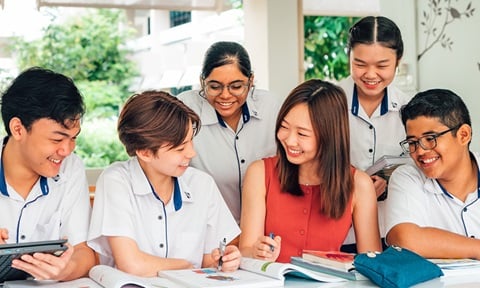In turbulent times, the young need the arts more than ever
For years, I would take my literature class out for annual learning journeys to the National Gallery Singapore.
Most of the class would never have stepped into the Gallery and some would never even have heard of it.
Given that knowledge of art is a proxy for cultural literacy, I would insist that every literature student of mine join the excursion.
Fortunately, every visit to the Gallery would be an enjoyable and memorable day out for my students. They would recite poems based on the artworks at the actual locations.
They would watch performances inspired by selected paintings and sculptures. Often, they would even get to interact with the exhibits that permitted or encouraged visitors to be actively involved in the process of creating art.
Of course, Covid-19 put an abrupt halt to all of such excursions. It seemed to mark a sudden end to all the wonder of discovery and awe of exploration that such visits can trigger.
Even now, when visits to art galleries, museums and other places of interest are permitted, strict controls and social distancing measures remain that may discourage schools from organising learning journeys for students en masse.
Such disruptions to tours and visits, however, should not diminish the importance of art education programmes for students. While it is tempting to relegate the arts to the periphery when other urgent priorities loom, that would be a mistake.
It is my firm belief that all students deserve access to the fine arts, no matter how difficult the times may be, and regardless of students' socio-economic status. My point is to make the case for greater support of arts institutions in Singapore that play a crucial role in widening the horizons of our younger generations and for the public at large.
Examples of artworks from the National Gallery Singapore would suffice to justify the point. I focus on the Gallery not because of any assumption about the supposed superiority of "high art", and certainly not to overlook the many other distinguished museums of Singapore, but because the Gallery is a leading visual arts institution that my students and I have visited for years.
CATHARTIC EXPERIENCE
First, to paraphrase Shakespeare, art is a mirror held up to nature: In the face of all the challenges and anxieties that afflict us, art offers a vital channel for our hopes, fears and dreams, presenting an unparalleled means of emotional release while revealing all that makes us human.
Art, in other words, can be supremely cathartic. Consider, for instance, Boschbrand (Forest Fire, 1849) by Javanese painter Raden Saleh. A gripping depiction of wild animals driven by flames to the edge of a precipice, this oil painting is the largest of the artist's works. In this violently dramatic scene, showcasing nature red in tooth and claw, the epic grandeur and savage energy of the work are apparent.
I recall how, during pre-pandemic days, my students and I watched an impressive spoken-word performance right in front of this magisterial composition.
The performer's impassioned delivery made one almost feel the heat of the blazing fire, hear the groans of the crushing stampede, or even catch a whiff of the acrid smoke, just at the moment before the beasts plunge to their fate.
It was a fitting reminder of how art draws upon life to refine viewers' aesthetic sensibilities through diverse images, metaphors and symbols that ignite and enliven the creative imagination.
My class also had a chance to get up close with the monumental painting. One student observed the artist's keen attention to detail and technical mastery in depicting light and shadow. Another student suggested that the painting could be interpreted today as an allegory of the climate crisis, given the threat of global warming to the planet and its destructive effects on wildlife.
If just one artwork could prompt such richly diverse reflections, imagine the combined influence of the rest of the collection on young minds. One of the greatest lessons from all my students' visits to the Gallery then has been this: Regardless of whichever countries or cultures they derive from, artworks can speak a universal language - not just of beauty but also of longing, sympathy and even healing.
In turbulent times, can we still afford to bring art to young audiences? My answer would be an unequivocal "yes". Efforts can always start small. Last year, in the wake of the circuit breaker period, I co-edited and published a multilingual book of poems inspired by artworks at the Gallery.
Due to social distancing protocols, the launch of the anthology - entitled Love And Life At The Gallery - had to be held online.
In some ways, having to go online was a blessing in disguise, because we managed to reach out to a much wider audience than we otherwise could have - especially for an event about poetry and art.
Given that poetry and art is a rather niche interest, a physical launch would likely have involved a mere handful of guests, possibly at the Gallery cafe or a local arts venue. A total of 540 viewers - including several of my students - tuned in to the book launch, with about a dozen actively commenting on Facebook Live.
Other virtual arts events have been similarly well received. Poetry Festival Singapore, for instance, was broadcast live from The Arts House on social media last August, with viewership numbers of the festival's various events ranging between 202 and more than 6,500.
Can more of such virtual events be held to raise awareness about the masterpieces of the National Gallery Singapore and other arts institutions? Can we leverage videoconferencing tools or virtual reality and augmented reality technology to grant more students an opportunity to embark on virtual visits of more Singapore museums, and perhaps some of the greatest art galleries in the world?
For instance, the National Gallery Singapore has organised virtual tours of the Gallery for teachers. I joined one such tour and learnt about the rich history of the Gallery's architecture, as well as stories behind artworks.
INDISPENSABLE PROGRAMMES
While we may not be able to replicate the sense of wonderment and awe that an in-person visit can offer, at least such virtual visits would allow students to be acquainted with - and inspired by - more South-east Asian artworks that they would otherwise never have known about.
Virtual tours could also be tailored and adjusted based on students' interests, considering the Gallery's experience in curating and selecting artworks that speak directly to younger viewers.
Far from being an optional afterthought, arts exposure programmes are indispensable for students. Years after my first few batches of students had graduated, I remember how pleasantly surprised I was to encounter them - some of whom I would never have imagined developing a fondness for the arts at arts events like the Gallery Children's Biennale.
As poet and dramatist Bertolt Brecht famously observed: "In the dark times, will there also be singing? Yes, there will also be singing. About the dark times."
The arts are an unquenchable flame that lingers, even at the edge of a precipice.
It is my firm belief that all students deserve access to the fine arts, no matter how difficult the times may be, and regardless of students' socio-economic status.
About the author:
Ow Yeong Wai Kit is a Postgraduate Diploma in Education alumni from NIE Class of 2015. He is also one of six recipients of the Outstanding Youth in Education Award 2019.
Source: The Straits Times © Singapore Press Holdings Limited. Permission required for reproduction.




.tmb-listing.jpg?Culture=en&sfvrsn=13b00373_1)


